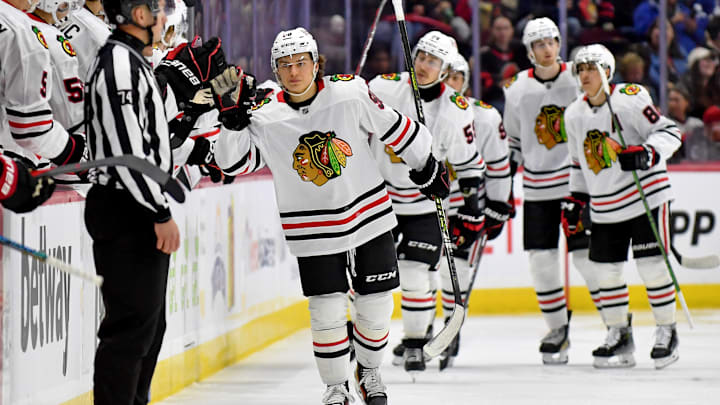As the Chicago Blackhawks ended a disappointing season that saw them finish in the Central Division cellar, a silver lining emerged for the team. The club’s numbers showed signs of potential top 5 offense despite a minus-70 goal differential this year.
That lopsided goal differential should be taken with a grain of salt. It isn’t so much an indictment on the Blackhawks’ offense than it is a reflection of the team’s porous defense. But we’ll save the discussion about defense for another day.
For now, we’re focusing on the potential upside the offense could deliver moving forward. Let’s look at the main numbers first. The Blackhawks ended the season with a 2.73 goals-for-average.
That’s not awful. The number tied them with the New York Islanders and was slightly below the Minnesota Wild (2.74), a playoff team. The Blackhawks also ranked above the Calgary Flames, who took their playoff bid down to the last game of the season.
But where the Blackhawks showed the most potential was in shooting percentage. Shooting percentage refers to the number of goals scored based on the number of total shots taken by the team.
That number reflects how efficiently teams score. The higher the percentage, the more goals scored based on the number of shots taken. That number showed the Blackhawks ninth in the league with an 11.2 shooting percentage. Unsurprisingly, the Washington Capitals led the league in that department.
But the top 10 also featured other big clubs like the Winnipeg Jets, Toronto Maple Leafs, and Dallas Stars. In other words, the Blackhawks have the potential to boast a top-10 offense. The problem is they haven’t been shooting enough.
The Chicago Blackhawks must shoot more to score more
My premise here is that if the Blackhawks shoot more, they will score more. It sounds simple, but the numbers back it up.
Let’s crunch some numbers for a second. The Blackhawks finished dead last in the league in shots on goal. They fired 2,005 shots over the full 82-game season. That works out to 24.45 shots per game. If we multiply that by the 11.2% shooting percentage, that comes out to 2.73 goals per game. So far, so good.
Now, let’s assume the Blackhawks shoot more. Let’s say they go bonkers and match the Colorado Avalanche, who finished fifth in the league with 2,451 shots. Let’s round that off to 2,450 shots.
If we multiply 2,450 times the Blackhawks’ 11.2 shooting percentage, that works out to 274.4 total goals in the season. When we take that total and divide it among the 82-game season, we get 3.35 goals per game.
Guess what? The Blackhawks are now tied with the Winnipeg Jets and Dallas Stars, who finished tied for third in the league in goals for.
All of a sudden, the Blackhawks now have a top-5 offense, and all that substantially changed was the number of shots on goal they took.
What about the minus-70 goal differential?
Even if nothing else remained unchanged defensively. Assuming the Blackhawks finished second in the league in most goals allowed at 292, the goal differential suddenly shrinks from minus-70 to minus-18.
18 goals is something the team can work on bringing down just by playing more focused hockey and getting more consistent goaltending.
All told, the Chicago Blackhawks have the potential to turn things around next season. It all boils down to the team shooting the puck more. They have the talent to score, it’s just a matter of putting more pucks on net.
